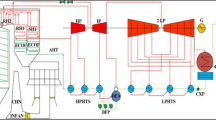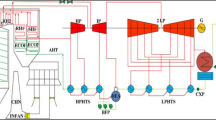Abstract
In a conventional coal-fired boiler combustion of coal causes buildup of soot, ash, and slag in the heat transfer surfaces, which reduces the heat transfer as well as operating efficiency. To achieve a high operating efficiency and improving heat transfer in boiler pressure parts, sootblowing is an important phenomenon in boiler operation. Boiler operators are typically provided with little or no information about the fouling status of heating surfaces or with much guidance regarding how to optimize sootblowing operations even if there are some indications like metal temperature, sprays. This raises the requirement of sootblowing optimization strategy to determine which portions of the boiler to clean and on what schedule. The objective of this study is to develop a sootblowing optimization system that uses thermodynamic model and artificial neural networks model to predict the effectiveness of heating surfaces. In addition, the system utilizes an optimization algorithm to refine the search for the optimal sequence of sootblower frequency and achieve boiler performance targets.









Similar content being viewed by others
Abbreviations
- A :
-
Area (m2)
- d :
-
Diameter (m)
- h :
-
Enthalpy (kJ/kg)
- K :
-
Heat transfer coefficient (kW/m2 K)
- L :
-
Length (m)
- m :
-
Mass flow (kg/s)
- Nu:
-
Nusselt number (−)
- Pr:
-
Prandtl number (−)
- P:
-
Price (Rs)
- p :
-
Pressure (kg/cm2)
- Q :
-
Heat flow (kW)
- Re :
-
Reynolds number (−)
- T :
-
Temperature (°C)
- ε :
-
Heating surface effectiveness (−)
- α :
-
Heat transfer coefficient (kW/m2 K)
- ΔT m :
-
Log mean temperature difference (K)
- λ :
-
Heat conduction coefficient (kW/K)
- FURN:
-
Furnace
- PCYL:
-
Per sootblowing cycle
- REH:
-
Reheater
- SHDP:
-
Super heater divisional panel
- SHPL:
-
Super heater Platen
- SB:
-
Sootblowing
- STM:
-
Steam
References
Afgan NH, Carvalho MG, Coelho P (1996) Concept of expert system for boiler fouling assessment. Appl Therm Eng 16(10):835–844
Anson D, Barrett RE, Litt RD, Paisley MA (1987) Salg monitoring for utility boilers. EPRI Final Report RP1893-5
Ayyagari SPK, Singh R, Purkayastha P, Deeskow P (2010) Estimation of soot deposition in the boilers of coal fired power plant. In: SYMOPA, Trivandrum, pp 362–367
Bechtler H, Browne MW, Bansal PK, Kecman V (2001) New approach to dynamic modelling of vapour-compression liquid chille: artificial neural networks. Appl Therm Eng 21(9):941–953
Bella O, Cortes C, Valero A, Tomás A (1994) Intelligent sootblowing system for coal-fired utility boilers. Conference papers of POWER–GEN EUROPE’94. Penwell, Colonia, Alemania, pp 355–362
Chappell RE, Locke JW (1965) A mathematical approach to automation of sootblower controls. In: Proceedings of the American power conference XXVII, pp 412–422
Cheng X, Kephart RW, Williams JJ (1999) Intelligent sootblower scheduling for improved boiler operation. In: POWID/EPRI instrument and control conference. Westinghouse Process Control Inc., St. Petersburg, pp 1–11
Cortés C, Bella O, Valero A, Tomás A (1993) Ash fouling monitoring and soot-blowing optimisation in a pulverised coal fired utility boiler. In: Proceedings of the tenth annual international pittsburgh coal conference, pp 703–708
Díez L, Cortés C, Campo A (2005) Modelling of pulverized coal boilers: review and validation of on-line simulation techniques. Appl Therm Eng 25:1516–1533
Energy Research Center, Lehigh University (1997) Optimize sootblowing to reduce NO x and improve heat rate. Energy Reserch Center 15(2):1–3. Available online www.lehigh.edu/~inenr/leu/leu_10.pdf
Gel O, Wieczorek JP (1999) Optimal induction motor design by the use of NLP-approximation approach and SQP method. J Electric Mach Power Syst 27:602–612
Gill PE, Murray W, Saunders MA (2002) SNOPT: an SQP algorithm for large-scale constrained optimization. SLAM J OPTIM Soc Ind Appl Math 12(4):979–1006
Gutiérrez-Arriaga CG, Serna-González M, Ponce-Ortega JM, El-Halwagi MM (2013) Multi-objective optimization of steam power plants for sustainable generation of electricity. Clean Technol Environ Policy 15(4):551–566
Hauschke A, Leithner R (2009) Dynamic simulation of fouling and optimization of sootblowing intervals in a hard coal fired power plant. In: 5th international conference on energy environment ecosystems development and landscape architecture (EEESD’09), Athens, pp 301–305
Houshfar E, Wang L, Vähä-Savo N, Brink A, Løvås T (2014) Characterisation of CO/NO/SO2 emission and ash-forming elements from the combustion and pyrolysis process. Clean Technol Environ Policy 16(7):1339–1351
Ilamathi P, Selladurai V, Balamurugan K, Sathyanathan V (2013) ANN- GA approach for prective modeling and optimization of NO x emission in a tangentially fired boiler. Clean Technol Environ Policy 15(1):125–131
Johnson R, Subasavage B, Breeding C (2004) Superheater fouling monitor system. Electric Power 2004, Baltimore, pp 3–10
Kalisz S, Pronobis M (2005) Investigations on fouling rate in convective bundles of coal-fired boilers in relation to optimization of sootblower operation. Fuel 84:927–937
Labbe D, Gordon L (2011) Continuous performance improvement in power generation. Invensys: 1–4 www.iom.invensys.com/EN/pdfLibrary/WhitePaper_Invensys_ContinuousPerformanceImprovementInPowerGeneration_03-11.PDF. Accessed 5 Nov 2014
Lefebvre WC, Kohn DW (2013) Method for sootblowing optimization. Patent US 8,447,431 B2
Marr R, Rhodes E, Wynnyckyj JR, Rolf J (1984) An instrument system to monitor and control fouling and slagging in large utility boilers. In: Proceedings of the third engineering foundation conference on slagging and fouling due to impurities in combustion gases, pp 118–138
Moss WH, Popiel L, Scheib TJ (1984) Sootblowing optimization. United States Patent 4,475,482
Paist A, Poobus A, Tiikma T (2002) Probes for measuring heat transfer parameters and fouling intensity in boilers. Fuel 81:1811–1818
Peña B, Teruel E, Díez LI (2011) Soft computing models for soot-blowing optimization in coal fired utility boilers. Appl Soft Comput 11(2):1657–1668
Peña B, Teruel E, Díez LI (2013) Towards soot-blowing optimization in superheaters. Appl Therm Eng 61(2):737–746
Ramirez BA (2000) Determination of cleanliness status of boiler heat transfer surfaces by using artificial intelligent techniques. Theses and Dissertations, Lehigh University
Rhode MA (2004) Tampa electric neural network sootblowing. www.osti.gov/bridge/servlets/purl/900192-uBMBCK/900192.pdf. Accessed 23 July 2010
Romeo L, Gareta R (2006) Hybrid system for fouling control in biomass boilers. Eng Appl Artif Intell 19:915–925
Romero CE, Sarunac N, Bilirgen H, Bokowski J, Cilinski M (2005) Comprehensive approach to performance improvement and emissions reduction on a 400 MW tangentially-fired boiler: part 1 combustion optimization. In: 30th international technical conference on coal utilization and fuel systems. Available at www.lehigh.edu/~inenr/research/PDF/Process%20Optimization_Paper%201.pdf
Samad T, Foslien W, Mathur A, Metha A (1994) Identification and control of ash deposition with neural networks. EPRI conference on the effects of coal quality on power plants. In: Proceedings of the fourth international conference. EPRI-TR-104982
Sarunac N, Romero CE (2004) Sootblowing operation: the last optimization frontier. In: 29th international technical conference on coal utilization and fuel systems, pp 1167–1178
Simon S, Frach M, Jochum B, Lang A (2006) Increase of steam generator output firing coal qualities through new intelligent on-load cleaning technology. VGB PowerTech 86(11):40–45
Subramanian S, Sundara Raman TG, Krishna Anand S (2011) Fuzzy predictive control for intelligent soot blowing. Eur J Sci Res (EuroJournals Publishing, Inc.) 50(1):135–142
Svanberg K (1997) The method of moving asymptotes: a new method for structural optimization. Int J Neumer Methods Eng 24:359–373
Swift SM, Vulicevic I, Conrad RS, Karloff J (2006) Boiler performance improvement due to intelligent sootblowing utilizing real-time boiler modeling on tangentially fired boilers. Electric Power 2006, Atlanta, pp 1–16. Available at www.babcock.com/library/Documents/br-1769.pdf
Taler J, Trojan M (2008) Computer system for on-line assessment of fouling of boiler heating surfaces. Energetyka 55(10):675–679
Taler J, Trojan M, Taler D (2009) Assessment of ash fouling and slagging in coal fired utility boilers. In: Proceedings of international conference on heat exchanger fouling and cleaning VIII, pp 103–112
Taler J, Duda P, Węglowski B, Zima W, Grądziel S, Sobota S, Taler D (2009b) Identification of local heat flux to membrane water-walls in steam boilers. Fuel 88:305–311
Taler J, Trojan M, Taler D (2010) Computer system for on-line monitoring of slagging and fouling and optimization of sootblowing in steam boilers. In: 2nd international conference on engineering optimization, Lisbon, pp 1–12
Teruel E, Cortés C, Díez L, Arauzo I (2005) Monitoring and prediction of fouling in coal-fired utility boilers using neural networks. Chem Eng Sci 60:5035–5048
Tomenko V, Ahmed S, Popov V (2007) Modelling constructed wetland treatment system performance. Ecol Model 205:355–364
Valero A, Cortés C (1996) Ash fouling in coal-fired utility boilers. Monitoring and optimization of on-load cleaning. Prog Energy Combust Sci 22:189–200
Wongsuwarn H (2010) Modeling of thermodynamic properties based on neurofuzzy system for steam power plant. In: WCECS 2010, San Francisco, pp 966–971
Yao Y, Gong JK, Cui Z (2014) Anti-corrosion performance and microstructure analysis on a marine concrete utilizing coal combustion byproducts and blast furnace slag. Clean Technol Environ Policy 16(3):545–554
Author information
Authors and Affiliations
Corresponding author
Rights and permissions
About this article
Cite this article
Pattanayak, L., Ayyagari, S.P.K. & Sahu, J.N. Optimization of sootblowing frequency to improve boiler performance and reduce combustion pollution. Clean Techn Environ Policy 17, 1897–1906 (2015). https://doi.org/10.1007/s10098-015-0906-0
Received:
Accepted:
Published:
Issue Date:
DOI: https://doi.org/10.1007/s10098-015-0906-0




